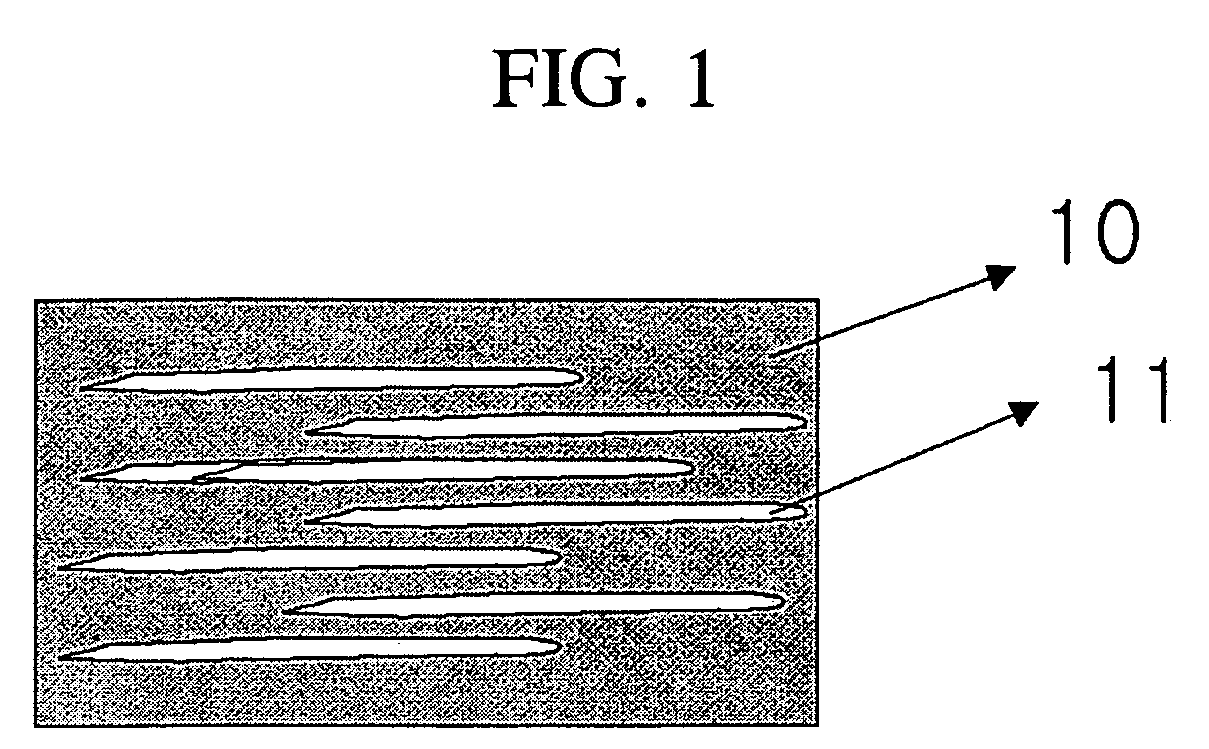Nanocomposite composition having high barrier property
a technology of nanocomposites and compositions, applied in nanotechnology, nanotechnology, nanotechnology, etc., can solve the problems of insufficient oxygen and organic solvent barrier properties, limited amount of resins used, and high cost of ethylene-vinyl alcohol copolymer and polyamide resins, so as to maximize the barrier property, reduce the sagging of parison, and increase the moisture and liquid barrier properties of polypropylene resins
- Summary
- Abstract
- Description
- Claims
- Application Information
AI Technical Summary
Benefits of technology
Problems solved by technology
Method used
Image
Examples
preparation example 1
(Preparation of Polypropylene / Intercalated Clay Nanocomposite)
[0048] 97 wt % of a polypropylene random copolymer (copolymer of propylene and ethylene, R724, M.I.: 1.9 (ASTM D1238, 230° C., 2160 g)) were put in the main hopper of a twin screw extruder (SM Platek co-rotation twin screw extruder; Φ40). Then, 3 wt % of organic montmorillonite (SE3000) as an intercalated clay and 0.1 part by weight of IR 1010 as a thermal stabilizer based on total 100 parts by weight of the polypropylene random copolymer and the organic montmorillonite were simultaneously put in the main hopper of the twin screw extruder to prepare a polypropylene / intercalated clay nanocomposite in a pellet form. The extrusion temperature condition was 200-210-210-210-210-210-205° C., the screws were rotated at 300 rpm, and the discharge condition was 40 kg / hr.
example 1
(Biaxial Stretch Blow Molding)
[0049] 20 parts by weight of the polypropylene nanocomposite prepared in the Preparation Example 1 and 80 parts by weight of polypropylene (R754) were dry-blended in a double cone mixer (MYDCM-100, MYEONG WOO MICRON SYSTEM) for 30 minutes and put in the main hopper of a biaxial stretch blow molding machine. The dry-blend was injected into a mold with a surface temperature of 23° C. under the processing temperature condition of 210-240-240-240° C. and an injection pressure of 50 kg / cm2 to form a parison. Then, the parison was removed from the mold. The parison had a neck-portion with a diameter of 24.0 mm and a body portion with a length of 40 mm and a thickness of 3.5 mm. An injection time was 6.7 seconds and a cooling time was 2.3 seconds. The surface temperature of the parison body was 105° C. The obtained hot parison was put into a blow mold and a stretch load was introduced inside the parison to stretch a low portion of the parison in a longitudina...
example 2
(Direct Blow Molding)
[0050] 20 parts by weight of the polypropylene nanocomposite prepared in the Preparation Example 1 and 80 parts by weight of polypropylene (R754) were dry-blended in a double cone mixer (MYDCM-100, MYEONG WOO MICRON SYSTEM) for 30 minutes. Then, the dry-blend was put in the main hopper of a blow-molding machine to form a parison under the processing temperature condition of 200-220-200-200° C. at an extrusion rate of 10 kg / hr. Next, the parison was put into a mold at a temperature of 25° C. The mold was closed and air was blown into the parison. The parison was cooled, and then removed from the mold. The parison had an inner diameter of 36 mm, an outer diameter of 40 mm, and a body thickness of about 2 mm. The parison was put into a blow mold and pressurized air with a pressure of 5 kgf / cm2 was blown into the parison for 20 seconds to stretch the parison in a transverse direction, thereby obtaining a container. The container had an inner height of 140 mm, a dia...
PUM
| Property | Measurement | Unit |
|---|---|---|
| wt % | aaaaa | aaaaa |
| melt index | aaaaa | aaaaa |
| surface temperature | aaaaa | aaaaa |
Abstract
Description
Claims
Application Information
 Login to View More
Login to View More - R&D
- Intellectual Property
- Life Sciences
- Materials
- Tech Scout
- Unparalleled Data Quality
- Higher Quality Content
- 60% Fewer Hallucinations
Browse by: Latest US Patents, China's latest patents, Technical Efficacy Thesaurus, Application Domain, Technology Topic, Popular Technical Reports.
© 2025 PatSnap. All rights reserved.Legal|Privacy policy|Modern Slavery Act Transparency Statement|Sitemap|About US| Contact US: help@patsnap.com

